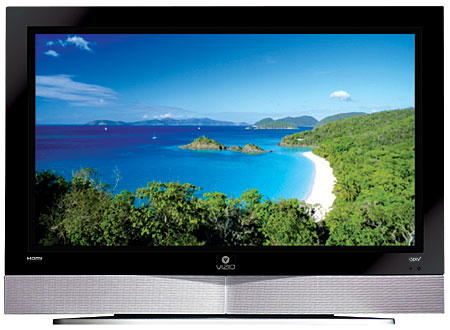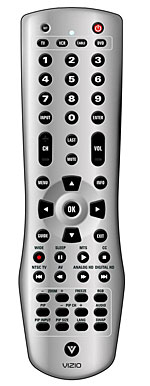VIZIO L42HDTV and GV42L LCDs Vs. VIZIO P42HDTV Plasma

The Vizio L42HDTV
LCDs are brighter and generally a bit more expensive than plasmas—though the cost differential is diminishing rapidly. Plasmas are not available in sizes smaller than 37" (or smaller than 42"for high-definition models). Plasmas are susceptible to "burn-in," LCDs are not. An LCD's image deteriorates more rapidly when viewed off-axis, and plasmas also do better on fast motion and have deeper blacks.
The above paragraph is, of necessity, a simplification of a complex set of strengths and weaknesses, and if you research the subject long enough you'll find experts eager to argue about most of them. Not only are both technologies evolving, but these characteristics also differ from brand-to-brand and model-to-model. But it's nevertheless a good idea to keep them in mind when shopping, particularly since you can't always audition a wide variety of program material on the sets you're interested in. Good luck finding a store using Dark City for demonstrations!
There have been attempts in the past to compare LCD to plasma in print and on-line, but they nearly always involved models from different manufacturers, often at very different prices and sometimes in different sizes. That simply results in too many variables to be of any real value to the consumer.
VIZIO, however, offers 42-inch LCD and plasma sets that are comparable in price. The main event in this report is, in fact, a face-off between VIZIO's P42HDTV plasma ($1,399.99) and L42HDTV LCD ($1,599.99)—two sets that are so similar in style that you could easily confuse one for the other on the showroom floor. The only sure way to tell them apart, when they're turned off, is the shiny, reflective glass screen on the plasma and the matte-finished screen on the LCD—a difference that's characteristic of LCDs and plasmas in general.
After I finished the basic review you'll read here, I discovered that there was new LCD model from VIZIO, the GV42L. Since the GV42L is only $100 more expensive than the L42HDTV, I asked VIZIO if they would send along a sample of that display as well. They did. I'll cover the GV42L in a separate discussion near the end of this report.
A Caution
While the results here will have some relevance to LCDs vs. plasmas across the board, there are significant model-to-model and manufacturer-to-manufacturer variations (not to mention ongoing technological developments) that make it unfair to universally ascribe the characteristics reported here to other LCD and/or plasma sets. But keeping that caution in mind, what I observed in this review was generally consistent with my previous experiences with these two technologies.
LCD Me
Other than noting its 1024x768 resolution, which turned out to be a factor in my viewing results, I won't spend much time here describing the features and general performance of the VIZIO plasma. I will save my comments on the P42HDTV for the comparative assessment later in the report. We reviewed the P42HDTV last spring, and for the full details, go here.
 The L42HDTV LCD, with its native resolution of 1366x768, accepts all incoming SDTV and HDTV resolutions except 1080p. It has a generous complement of inputs, including two HDMI inputs (the P42HDTV only has one), two component inputs, and one RGB PC. One of the HDMI inputs has separate L/R analog audio connections for those who want to feed sound from a source into the set's audio system, but also need to use a DVI-to-HDMI adapter cable. (An HDMI connection at both the source and receiving ends will carry both video and audio to the set; a DVI-to-HDMI cable is video only).
The L42HDTV LCD, with its native resolution of 1366x768, accepts all incoming SDTV and HDTV resolutions except 1080p. It has a generous complement of inputs, including two HDMI inputs (the P42HDTV only has one), two component inputs, and one RGB PC. One of the HDMI inputs has separate L/R analog audio connections for those who want to feed sound from a source into the set's audio system, but also need to use a DVI-to-HDMI adapter cable. (An HDMI connection at both the source and receiving ends will carry both video and audio to the set; a DVI-to-HDMI cable is video only).
There are also separate stereo L/R analog audio connections for the other video inputs, plus stereo L/R analog outputs to route sound from the set to your outboard AV receiver or pre-pro. An optical digital output does the same for the digital sound from the set's integrated NTSC/ATSC tuner, up to and including 5.1-channel Dolby Digital. The L42HDTV's own sound system is unexceptional, which is unsurprising and typical of other flat panel displays we've tested.
The programmable remote is a good one, and identical to the remote in the P42HDTV. It isn't illuminated, but the buttons are reasonable in number, comfortably spaced, and relatively easy to find by feel in the dark. It's also programmable and can control three other devices as well as the TV.
There is no cableCARD HD tuner. An on-screen guide offers program schedule information, provided the set's over-the-air stations include this in their signals. This guide is not as useful as the program guide offered by my local cable carrier, but the mileage of your cable carrier or satellite provider may vary.
The L42HDTV has four Picture Modes. The only one that provides a full range of user adjustments is Custom. In this mode you can set the Backlight level and Color Temperature, as well as the usual Brightness, Contrast, Color, Tint, and Sharpness. All of these controls may be adjusted individually for each input.
The Color Temperature has four settings: Warm, Normal, Cool, and Custom. The Custom setting provides overall adjustment of red, green, and blue for calibration, but does not offer separate adjustments for the top and bottom of the brightness range. This shortcoming mattered little in getting a good result (see the "Tests" section).
All of these calibration adjustments are in the user menu. The Color Temperature can be set separately for specific groupings of inputs (HDMI 1 and HDMI 2 together, Component 1 and Component 2 together) but not for every individual input.
There are other features as well, most of them common to many sets on the market, including such stalwarts as audio controls (including one of those simulated surround modes), PIP, POP, and Parental Control. Rather than spend time on these features here, go to the VIZIO website, www.viziotv.com. From there you can download the entire owner's manual.
Performance: L42HDTV
I started my viewing with the superb DVD transfer of Charlotte Gray. The greens from this source were about average in intensity for a digital display, which means they were slightly too saturated. That was also true of flesh tones; even after calibration I had to turn the Color control down a bit to keep everyone from looking like they had just spent a long day at the beach.























































